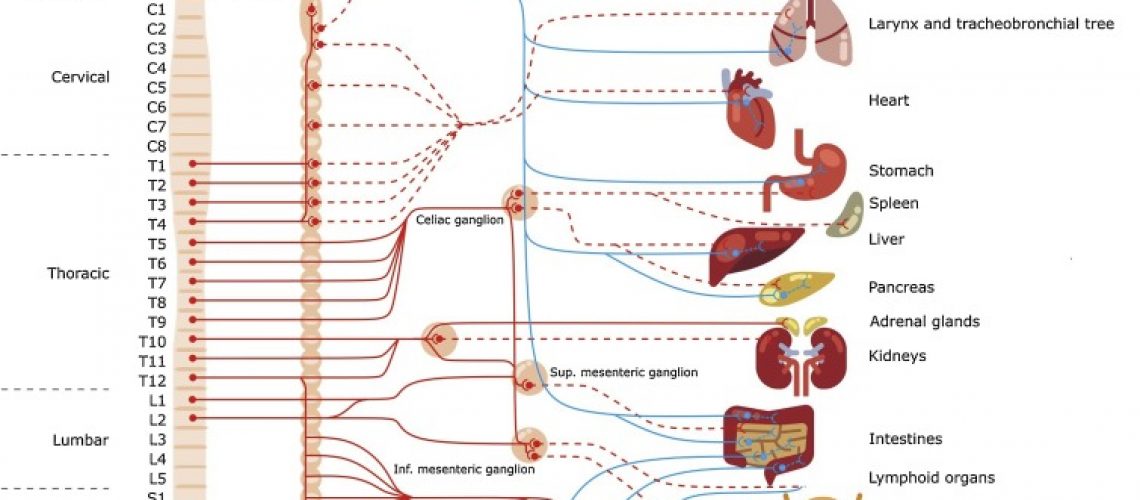Clubhouse 17th April 2021, VAGUS Rest Digest Immune Club
Google Scholar searches, results (hits):
Heart Rate Variability (all time), 2 820 000 (since 2020: 30300)
Vagal Tone: 110 000, (since 2020: 7350)
Vagus Nerve Stimulation – 234 000 (since 2020, 14600 and exact wording in heading: 3970)
Cholinergic immune system – 90 500 (since 2020: 10700 results)
Covid-19, Coronavirus or SArs-cov-2 & Vagus Nerve – 5640
Covid-19 & Cholinergic Immune System – 1080 studies (more than 700 are published in 2021)
“Long Covid”: 1400 (26 studies discussing Long Covid and the Vagus Nerve)
Summary from research papers:
The vagus nerve innervates most thoracic and abdominal organs and relays afferent and efferent information between peripheral receptors and effector cells and the brain. Cervical vagus nerve stimulation (cVNS) and transcutaneous vagus stimulation (tVNS) are potential treatment for a multitude of disorders affecting the brain and peripheral organs, including drug-resistant epilepsy, depression, Alzheimer’s disease, anxiety, pain, tinnitus, rheumatoid arthritis, heart failure, diabetes, obesity, pulmonary hypertension and others. Vagal tones (activity level of the vagus nerve) are good indicators of the state of the body’s autonomic nervous system, homeostatic regulation, cardiac/respiratory activity and immune system in general.
Dr. Stephen Porges. (Google Scholar Search: 2430 results, “Polyvagal Theory” is used in 1620 papers) Since its introduction by Dr. Porges more than two decades ago, the Polyvagal Theory and the Social Engagement System have provided a sophisticated understanding of the neurophysiology of emotions, trauma, attachment and self-regulation. The polyvagal theory focuses on the structure and function of the two efferent branches of the vagus cranial nerve, both of which originate from the medulla. Each branch is claimed to be associated with a different adaptive behavioural strategy; the ventral branches are more restful, ‘positive’ and for active social engagement and the dorsal ones are claimed to be responsible for the evolutionary older ‘freeze’ effect and connected with fatigue, sickness response, trauma and depression.
- The Polyvagal Perspective, Bil Psychol Feb 2007 and several other papers and books by Stephen Porges on Respiratory Sinus Arrythmia and the Polyvagal Theory.
Dr. Kevin Tracey. (Google Scholar: 2550 hits, “Vagus” or “cholinergic immune system”: 850 hits). President and CEO of the Feinstein Institutes for Medical Research. Dr. Tracey is considered the founding father of bioelectronic medicine for his discovery of the body’s Vagus nerve based inflammatory reflex. The Feinstein Institutes for Medical Research is the research arm of Northwell Health, the largest health care provider and private employer in New York State. It has 50 research labs, 3,000 clinical research studies and 5,000 researchers and staff.
- The vagus nerve and the inflammatory reflex—linking immunity and metabolism. Nat Rev Endocrinol. 2012 December. Valentin A. Pavlov and Kevin J. Tracey
- The inflammatory reflex. Dr. Kevin Tracey, Nature. 2020;
- Cytokine-specific Neurograms in the Sensory Vagus Nerve. Bioelectron Med. 2016, Kevin J Tracey et al,
- Mechanisms and Therapeutic Relevance of Neuro-immune Communication, Immunity, June, 2017 Sangeeta S. Chavan, Pavlov and Kevin J. Tracey
- Hacking the inflammatory reflex, article by Dr Kevin Tracey in in Lancet Rheumatology 1st Feb 2021.
- 3rd March 2021, Nature: Targeted peripheral focused ultrasound stimulation attenuates obesity-induced metabolic and inflammatory dysfunctions, Tomas Huerta, Kevin Tracey, Sangeeta S. Chavan. GE & Feinstein’s Ultrasound liver stimulation of vagal pathways provides new way in bioelectronic medicine to treat obesity and diabetes Chronic low-level inflammation which are known to play a role in obesity.
Dr. Edward Bullmore, (3350 hits on Google Scholar, British neuropsychiatrist, neuroscientist, and academic. Since 1999 Professor of Psychiatry at the University of Cambridge.)
- Book: The Inflamed Mind, book published 2018. Quotes: ‘Bearing in mind what we now know about how the vagus nerve controls inflammation, maybe we could use nerve-stimulation devices to treat inflamed depression? And recalling the crucial importance of stress for both inflammation and depression, maybe we can monitor the effectiveness of psychological and social interventions by inflammatory vagus biofeedback? We know from the recent discovery of the inflammatory reflex that the vagus nerve controls cytokine release by macrophages in the spleen. We also know that vagal nerve stimulation by an electrical device implanted in the body can dramatically reduce inflammation.
Dr. Antonio Damasio. (3890 hits on Google Scholar, Neuroscientist. David Dornsife Chair in Neuroscience and Professor of Psychology, Philosophy, and Neurology, at the University of Southern California) Consciousness and the brainstem, Sept 2000 The brainstem is a primary component in consciousness and responsible for the modulation of the body’s homeostatic balance. Book published 2012: Self comes to mind.
Other selected ‘Vagus’ papers:
- Quantitative estimation of nerve fiber engagement by vagus nerve stimulation using physiological markers. Brain Stimulation, Chang & Zamos, April 2020.
- Gut Brain Axis: How microbiome influences anxiety and depression. 2013, Jane Foster, Canada ‘Disruption of microbiome can cause disease’
- Loss of Vagal anti-inflammatory effect in-vivo visualization and adoptive transfer, O Mahony, Aug 2009. The Vagus Nerve by releasing Acetycholine stimulates T-regulatory cells that lower inflammation.
- Heart Rate Variability as a Biomarker for Predicting Stroke, Post-stroke Complications and Functionality. Ty Lees, Sara Lee, 2018, Sydney. Various HRV parameters can function as biomarkers for incident stroke, a number of post-stroke outcomes, including motor impairment and mortality.
- Assessment of cardiac preload and left ventricular function under increasing levels of positive end-expiratory pressure. Leucke, Thomas; Roth, Harry (1993). Intensive Care Medicine. 30 (1): 119–126.
- Mechanism of decreased left ventricular stroke volume during inspiration in man. Pathophysiology and natural history. Authors: M. Karam, M.D., R. A. Wise et al.
- Effect of respiration on cardiac filling at rest and during exercise in Fontan patients: A clinical and computational modeling study. IJC Heart & Vasculature, Volume 9, 7 December 2015, Pages 100-108 Authors: Alexander Van De Bruaenea
- Respiratory change in ECG-wave amplitude is a reliable parameter to estimate intravascular volume status: Journal of Clin Monit Comput. Giraud R. Siegenthaler N. Morel DN,
- Two Distinct Responses of Left Ventricular End-Diastolic Pressure to Leg-Raise Exercise in Euvolemic Patients with Exertional Dyspnea, Korean Circulatory Journal, May 2016. Authors: SeongIl Choi, MD1 , Jeung-Hun Shin, MD1 , Whan-Cheol Park, MD1 , Soon-Gil Kim, MD1 , Jinho Shin, MD2 , Young-Hyo Lim, MD2 , and Yonggu Lee, MD3,
- Theoretical Analysis of Intracavitary Blood Mass Influence on the Heart-Lead Relationship, 1956, By Daniel A. Brody, M.D.
- The Brody effect and change of the volume of the heart. J. Electrocardiology 18, 1985, J. N. Amoore
- The Brody Effect Revisited, Journal of Electrocardiology, October 1991, A. Van Oosterom, R. Plonsey.
- Respiratory change in ECG-wave amplitude is a reliable parameter to estimate intravascular volume status, J. Clin Monit Comput (2013) 27:107–111, Raphael Giraud, Nils Siegenthaler, Denis R. Morel • Jacques-A Romand, Laurent Brochard • Karim Bendjelid
- Respiratory sinus arrhythmia in humans: how breathing pattern modulates heart rate, 1981, Judith Ann Hirsch, Beverly Bishop.
- Toward Understanding respiratory sinus arrythmia: Relations to cardiac vagal tone, evolution and biobehavioral functions. Biological Psychology 74, 2007. Paul Grossman, Edwin W. Taylor.
- Accuracy of assessment of cardiac vagal tone by heart rate variability in normal subjects. Am J Cardiol 1991, Hayano J, Sakakibara Y. Yamada A, et al.
- Respiratory modulation of cardiac vagal tone in Lyme disease. World J Cardiol, June 2014. Basant K. Puri, Musadiq Shah, Jean A. Monro, Michele C. Kingston, Peter OO Julu.
- Anatomic connections of the diaphragm influence of respiration on the body system.. Bordoni, B., & Zanier. (2013). Journal of Multidisciplinary Healthcare, 281.
- Techniques of EMG signal analysis: detection, processing, classification and applications, Raez, Hussain & Mohd-Yasin, 2006
- Physiology of the Autonomic Nervous System, Laurie Kelly McCorry, 2007
- Vagal tone diagnostics with hand-to-hand electrocardiogram (ECG). Gustaf Kranck, study presented at BFE in April 2019.

